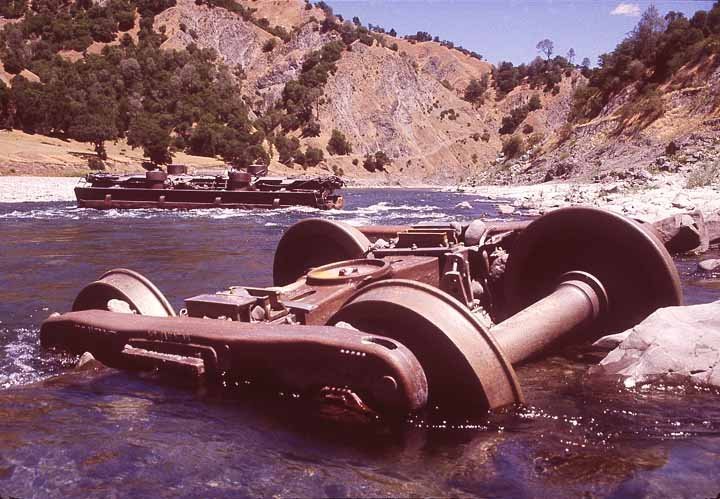
File photo: Friends of the Eel River.
In its annual report to the California State Legislature, which was release today, the California Transportation Commission calls for the formation of a special committee to study and make recommendations for the future of the North Coast Railroad Authority.
The state agency, now nearly 30 years old, holds title to the railroad tracks that run between Humboldt County and the Bay Area. Though some freight has lately been moving on the very southern end of the line, no trains have reached Humboldt County in two decades.
Back in July, the state commission — whose mandate is, in part, to advise the legislature on transportation matters — held a hearing on the railroad authority’s dire finances, and asked it to produce two documents: a business plan and a “shutdown” plan. The authority’s response, if any, has apparently been unpersuasive.
”To date, the NCRA has been unable to produce a plan that makes the business case for its existence,” writes the commission in its report to legislators today.
The authority is in an unusual position: It is a state agency that is currently selling off state assets, in part to pay for an appeal of a state Supreme Court decision that held it to state environmental laws. At a meeting earlier this week, it considered selling off its easements through Eureka’s Balloon Track to Rob Arkley’s Security National Servicing Corporation. That motion was tabled after objections from Caltrans, according to Richard Marks, one of Humboldt County’s two representatives on the board of the authority.
Excerpt from the California Transportation Commission’s 2017 report to the state legislature:
8. Create a committee of stakeholders to explore potential improvements to the North Coast Railroad Authority.
The Commission recommends that the Legislature create a committee of stakeholders involved in the development and operation of the North Coast Railroad Authority (NCRA) to explore various scenarios for the Authority’s future.
NCRA was created by State law in 1989 to maintain and expand rail service to the North Coast area of the State. There have been a series of loans and grants of federal and State funds provided to NCRA to purchase right of way, rolling stock and other equipment, and make improvements and repairs to related facilities.
Between 1991 and 2008, the Commission allocated Proposition 116, Transportation Planning & Development (Transit Capital Improvement Program), and Traffic Congestion Relief Program (TCRP) funding. The last reimbursement request by and authorized payment to NCRA by the Department was processed in January 2012.
In a recent presentation to the Commission, NCRA leadership shared that the enterprise is having difficulty maintaining and expanding rail service, has never been self-sufficient, and is routinely unable to pay its obligations. The Commission asked the NCRA representatives to provide a business plan identifying potential responsible directions the Authority can implement moving forward. To date, the NCRA has been unable to produce a plan that makes the business case for its existence.
Given the uncertain future direction expressed by the Authority’s management, the Commission believes that it is in the best interest of the state that a committee of stakeholders be formed to oversee the development of a plan for the future of this statutorily-created enterprise.
###
UPDATE: State Senator Mike McGuire had this to say, in a press release just issued:
“We greatly appreciate the research and thought that has gone into the CTC’s recommendation regarding the North Coast Railroad Authority,” Senator Mike McGuire said. “Their timing is excellent. Our office has been talking with representatives on all sides of this issue over the last several months, and we believe it is indeed time to resolve the issues highlighted by the Commission.
“In hindsight, decisions made two decades ago by state leaders to create a rail agency without some base level of funding was unrealistic. It is time for all of us to have an honest – and potentially difficult – conversation about exactly where it is practical for freight to operate on this line, and what is the highest and best use for the remaining miles of track.”
###
PREVIOUSLY:
- State Transportation Commission Raises Eyebrow at North Coast Railroad Authority Finances, Asks Perennially Beleaguered Agency to Prepare ‘Shutdown Plan’
- Government Railroad Agency Says It’s Still Looking to Bring Trains Back to Humboldt County, Even as its Finances and Fortunes Spiral Downward
- North Coast Railroad Authority, a State Agency, Will Ask U.S. Supreme Court to Rule That It is Not Bound By State Environmental Law
DOCUMENTS:
CLICK TO MANAGE